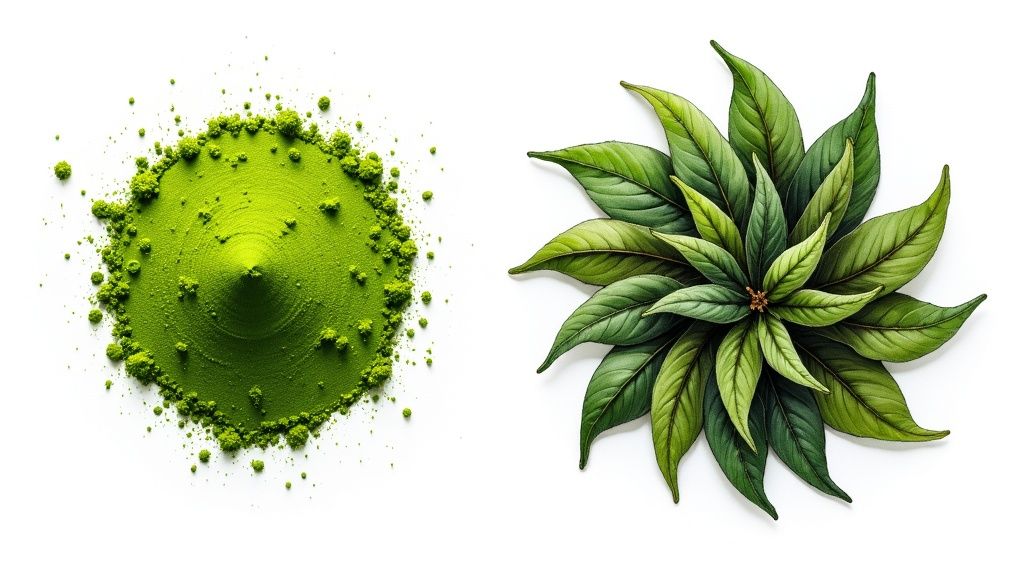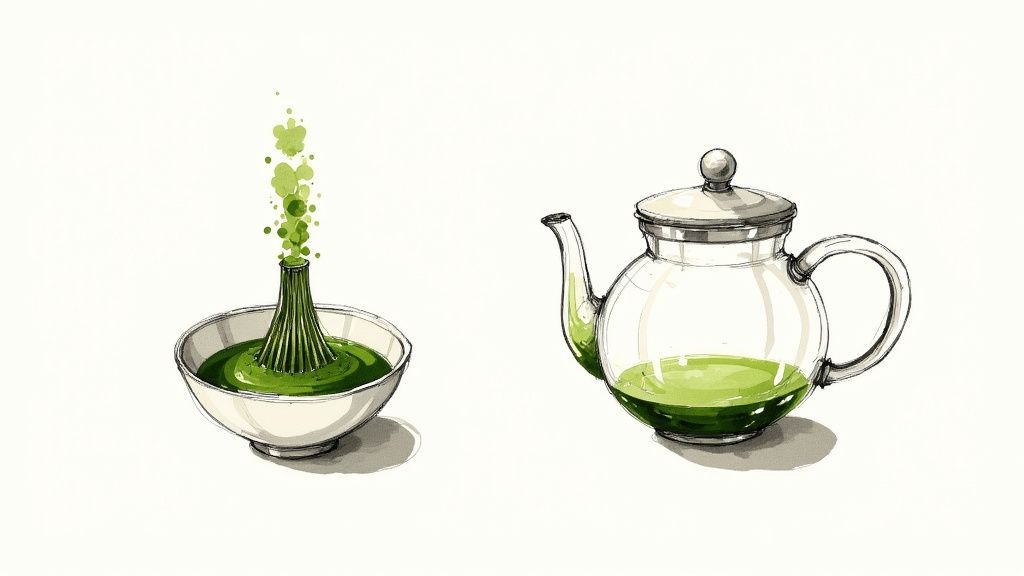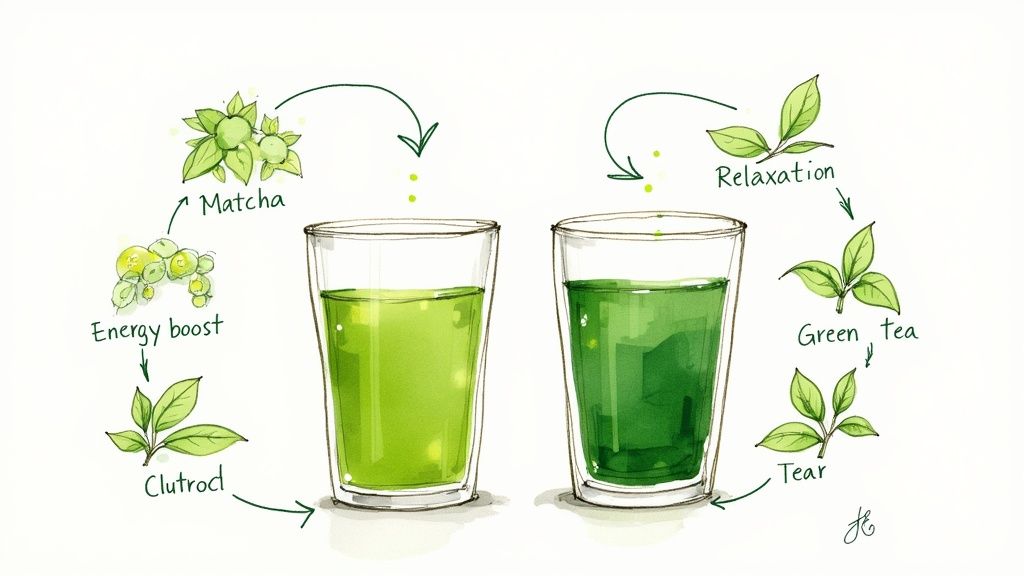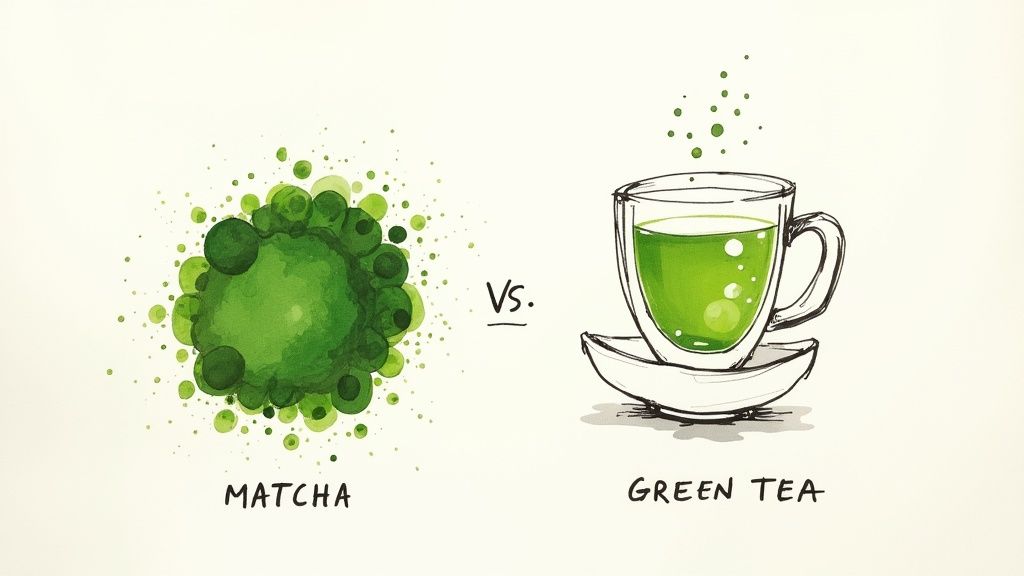The Art and Science of Tea Preparation

The preparation methods for matcha and regular green tea create two distinctly different experiences, from the initial processing to the final cup. While both come from the same plant, their paths diverge significantly, resulting in unique flavors, textures, and health benefits. Let's explore how these differences shape the character of each tea.
From Leaf to Powder: Matcha's Unique Journey
Making matcha follows an exacting process that begins weeks before harvest. Tea farmers shade the plants to boost chlorophyll production, creating vibrant green leaves rich in nutrients. These leaves are then stone-ground into a fine powder, preserving all their natural goodness. This method sets matcha apart from other teas right from the start.
Steeping vs. Whisking: A Tale of Two Teas
Regular green tea preparation involves steeping dried leaves in hot water and then removing them, much like brewing any other tea. This method extracts only some of the nutrients and flavor compounds into the water. With matcha, you whisk the powder directly into water, drinking the entire leaf. It's similar to eating a whole apple versus drinking apple juice – you get more nutrients when consuming the whole food. This fundamental difference explains why matcha delivers a more intense taste and fuller range of benefits.
Mastering the Matcha Method
Making a proper cup of matcha requires specific tools and techniques. First, sift the powder into a bowl to prevent clumps. Then add hot (but not boiling) water and whisk with a special bamboo tool called a chasen until you create a smooth drink topped with tiny bubbles. While some people use electric frothers for convenience, the traditional whisking method creates a better texture and adds to the mindful experience of preparation.
Brewing the Perfect Cup of Green Tea
Green tea needs careful attention too, even though it's simpler to prepare. The key lies in getting the water temperature and steeping time just right. Too hot or too long makes the tea bitter, while too cool or too brief leaves it weak and flavorless. Each variety has its own sweet spot – delicate Japanese teas like sencha need cooler water and shorter steeps than heartier Chinese varieties. When you understand these nuances, you can bring out the best in both matcha and regular green tea, appreciating what makes each one special.
Understanding the Unique Energy Experience

Matcha and regular green tea each provide an energy boost, but they affect your body in distinct ways. By getting to know these differences, you can pick the right tea for your needs – whether you need to focus at work or just want a gentle afternoon lift. The key lies in understanding how their unique properties and preparation methods shape their effects.
The Matcha Advantage: Sustained Energy and Calm Focus
Many people describe matcha's effect as creating "alert calm" – you feel energized and focused without the jittery feeling that often comes with coffee. This happens because matcha contains both caffeine and L-theanine, an amino acid that promotes relaxation. When these compounds work together, they create balanced, long-lasting energy. Since you drink the whole tea leaf in matcha form, you get more of these beneficial compounds than you would from steeped green tea.
Think of it like comparing two types of heat sources: matcha is like a steady flame that burns evenly for hours, while other caffeinated drinks are more like a quick flash that fades quickly. This steady energy makes matcha popular among students during long study sessions and professionals who need to stay sharp throughout their workday.
Regular Green Tea: A Gentler Lift
When you steep regular green tea, you get a milder energy boost compared to matcha. This happens because the steeping process only extracts some of the caffeine and L-theanine from the leaves. The result is perfect for times when you want a light pick-me-up without strong effects. It's more like a gentle tap on the shoulder rather than a strong push forward – ideal for a refreshing afternoon break.
Timing Your Tea for Optimal Effects
The timing of your tea matters just as much as which type you choose. Since matcha provides longer-lasting energy, it works well in the morning or early afternoon. However, some people find it affects their sleep if they drink it too late in the day. Regular green tea, with its lower caffeine content, is usually fine to drink later in the day since it's less likely to keep you up at night. Try different timing patterns to see what works best for your body's rhythms.
Choosing the Right Tea for Your Needs
Your ideal choice between matcha and regular green tea depends on what you want to achieve. If you need focused energy that lasts for hours without making you feel anxious or jittery, go with matcha. If you prefer a lighter boost and enjoy the traditional tea-steeping ritual, regular green tea might be your better option. By knowing how each tea affects your energy levels, you can make smart choices that fit your daily routine and help you feel your best.
Navigating the World of Antioxidants
When comparing matcha and regular green tea, one key difference lies in their antioxidant content. While both offer health benefits, understanding how they differ can help you pick the right tea for your needs. These teas get their protective properties from compounds called catechins, but the way you prepare and drink them affects how many antioxidants actually make it into your system.
Matcha: A Concentrated Dose of Antioxidants
Think of matcha like eating a whole leaf versus just drinking tea water – since you consume the entire ground tea leaf, you get all the beneficial compounds it contains. The special way matcha is grown and processed also concentrates these compounds. While some claims about matcha's antioxidant levels can be overstated, research suggests it contains about ten times more antioxidants than regular green tea. This makes sense, since you're consuming the whole leaf rather than just an infusion.
Green Tea: Still a Good Source of Antioxidants
Regular green tea delivers plenty of healthy compounds, even if not as concentrated as matcha. When you steep green tea leaves, beneficial antioxidants dissolve into the water, creating a healthy drink. Many studies show that drinking green tea regularly supports heart health and may help prevent certain diseases. The main difference is that steeping leaves extracts only some antioxidants, while eating the whole leaf in matcha provides the full amount.
EGCG: The Star Antioxidant in Both Teas
A particularly important antioxidant found in both teas is epigallocatechin gallate (EGCG). Research indicates that EGCG helps protect cells from damage, supports healthy metabolism, and strengthens immune function. Both matcha and regular green tea contain this beneficial compound, though matcha provides a more concentrated dose since you consume the whole leaf.
Maximizing Your Antioxidant Intake
When choosing between these teas, consider how much antioxidant power you're looking for. Matcha offers the highest concentration, but regular green tea is still an excellent choice and healthier than many other drinks. You might want to check out: How to master the differences between these two teas and other brews. Whether you prefer matcha or regular green tea, adding either one to your daily routine provides valuable antioxidants. The best choice depends on your taste preferences and health goals.
Mastering the Art of Tea Tasting

The tasting experience sets matcha and regular green tea distinctly apart. While both come from the same plant, their cultivation, processing, and preparation methods create two completely different flavor journeys. Let's explore what makes each unique and how to fully appreciate their individual characteristics.
Unveiling Matcha's Intensity
When you drink matcha, you're consuming the entire tea leaf in powdered form, which creates a rich and full-bodied experience. Think of it like eating a whole vegetable versus drinking its broth – the difference is clear and immediate. Matcha offers deep vegetal notes with natural sweetness and that distinct savory umami flavor that tea lovers seek. This depth comes from the special shading process before harvest, which concentrates certain compounds in the leaves.
Exploring Green Tea's Subtlety
Regular green tea presents a gentler experience since you're steeping the leaves rather than consuming them whole. This method allows for lighter, more varied flavors to emerge – from fresh grass and spring flowers to toasted nuts and light smoke. Each variety tells its own story through taste. It's similar to walking through a garden where every plant offers something different to discover.
The Impact of Cultivation: Shading and Flavor
The way tea farmers grow and process their leaves directly shapes what ends up in your cup. Matcha's distinctive taste comes from being shaded for several weeks before harvest, which boosts chlorophyll and amino acids like L-theanine. This creates that smooth, rich flavor with less bitterness. Regular green tea, grown in full sun, develops its own character through various growing regions and processing styles, giving us many different taste experiences to explore.
Training Your Palate: A Tea Tasting Journey
Becoming skilled at tasting tea takes practice and attention to detail. Begin by noting the scents – both from the dry leaves and the brewed tea. As you sip, consider: Is it sweet? Bitter? Grassy? What lingers after you swallow? This mindful approach helps you spot the differences between matcha and regular green tea. You might notice how matcha feels creamy with a sweet finish, while certain green teas leave you with a clean, refreshing sensation.
Finding Your Perfect Match: Quality and Preference
As you develop your tea-tasting skills, try different options within each category. Sample various grades of matcha from culinary to ceremonial quality to understand how grade affects taste. With regular green tea, explore varieties like sencha, genmaicha, and gyokuro to discover your favorites. Remember that the best tea is simply the one you enjoy most – there's no wrong choice when it comes to personal taste.
The Ultimate Wellness Impact Guide

When it comes to tea, matcha and regular green tea offer different benefits for your wellbeing. While both are healthy choices, their unique preparation methods and compositions create distinct effects on your body and mind. Let's explore these key differences to help you pick the right tea for your needs.
Antioxidant Powerhouse: Matcha vs. Green Tea
Both matcha and regular green tea contain powerful antioxidants called catechins, including EGCG, that help protect your cells from damage. The main difference lies in how you consume them. With matcha, you drink the actual tea leaves ground into a fine powder, giving you about ten times more antioxidants than a cup of steeped green tea. Think of it like eating a whole apple versus drinking apple juice – you simply get more nutrients from consuming the whole leaf. While regular green tea still provides good antioxidant benefits, matcha packs a stronger punch per serving.
A Tale of Two Energizers: Caffeine and L-Theanine
The energy boost you get from these teas also differs significantly. Matcha contains more caffeine (35-70mg per serving) than regular green tea (20-90mg) since you consume the whole leaf. But what makes matcha special is how this caffeine works with L-theanine, a calming amino acid. This combination creates a balanced energy – you feel alert and focused without the jitters that often come with coffee. Regular green tea offers a gentler lift since steeping only extracts some of the caffeine and L-theanine from the leaves. If you want a mild pick-me-up, regular green tea might be your better choice.
Nutritional Value: A Deeper Dive
The nutritional differences between these teas come down to how you prepare them. Since matcha involves consuming whole tea leaves, you get more vitamins, minerals, and beneficial compounds than you would from steeped green tea. Regular green tea still provides good nutrition, but matcha simply offers more of everything because nothing is left behind in the cup. This makes matcha particularly good for supporting your immune system and overall health, though both teas contribute positively to your daily nutrition.
Practical Applications for Your Wellness Journey
Your choice between matcha and regular green tea should match your personal needs. If you want maximum antioxidants and sustained energy, go for matcha. If you prefer a gentler experience with a more traditional tea taste, regular green tea is an excellent option. Consider factors like your energy needs, health goals, and taste preferences when choosing. You might even enjoy both at different times – matcha when you need an extra boost, and regular green tea for a relaxing afternoon break.
Making Your Perfect Tea Match
The choice between matcha and regular green tea comes down to your daily habits and taste preferences. Neither is inherently better than the other – they simply serve different purposes and suit different lifestyles. Let's look at the key factors that can help you decide which tea works best for you.
Time is of the Essence: Preparation Differences
The preparation method is often the first thing to consider. Regular green tea is straightforward – just steep the leaves or tea bag for a few minutes and you're ready to go. But matcha requires more attention and specific tools like a bamboo whisk (chasen) to achieve that smooth, frothy consistency. While some people enjoy the meditative aspects of whisking matcha, others find it impractical for busy mornings. If you need a quick caffeine boost before heading out, regular green tea might be your better option.
Budgetary Considerations: The Price of Premium Tea
Cost is another important factor to weigh. High-quality matcha costs more than regular green tea because of its careful production process – from shading the plants to grinding the leaves into fine powder. But matcha's concentrated form means a little goes a long way. One tin can provide several weeks of servings, and its rich nutrient content offers good value per cup. Regular green tea comes in many price points, from basic tea bags to premium loose leaves, making it easier to find options that fit your budget.
Lifestyle Integration: Finding the Right Fit
Both teas can add different benefits to your daily routine. Many people find matcha's steady energy boost perfect for productive workdays – helping them stay focused without the jitters often linked to coffee. Regular green tea, with its gentler effects, makes an excellent choice for relaxation. You might prefer sipping it during afternoon breaks or quiet evenings at home when you want to unwind.
Maximizing Your Tea Investment: Storage and Serving Tips
To keep either tea fresh, proper storage is essential. Keep matcha in an airtight container away from light and heat – your pantry or refrigerator works well. Similarly, store regular green tea in a cool, dark place to maintain its flavor. Both teas are versatile beyond hot drinks – try matcha in smoothies or baked goods, and experiment with iced green tea or herb-infused blends. These creative options help you enjoy your tea investment in multiple ways.
Ready to explore matcha's unique qualities? Visit matcha-tea.com to learn more about this traditional Japanese tea. You'll find preparation guides, recipes, and insights into Japanese tea culture to help start your matcha journey.
